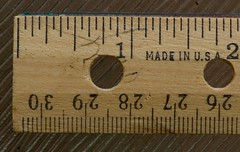
Photo by Angela Vincent on flickr.com
First things first, let’s tackle the big “problem” many daycare providers have – licensing. The IRS demands that you report all of your daycare income, but if you’re not licensed, you don’t qualify to claim any of the deductions. Now the whole licensing thing varies by state. Here in Missouri, you do not have to have a daycare license if you care for four or fewer children who are not related to you. If you’re exempt from licensing requirements for your state, then you’re qualified to claim all of the federal tax deductions relating to your daycare business. Different states have different rules. Just across the river in Illinois, the licensing requirements are much stricter. Be sure to look up the rules for your state before you claim daycare deductions.
Your daycare income will go on a form called Schedule C which will be part of your regular 1040 tax return. You are required to pay self-employment tax on your daycare income; that will be 13.3% for 2011, generally it’s 15.3%. Self employment tax is in addition to your regular income tax, so you can see why claiming your expense deductions can come in kind of handy.
The first, and probably the biggest, daycare deduction is for the business use of your home. That’s going to go on a Form 8829 and it’s going to be linked to your Schedule C. You won’t be able to deduct all of your rent, utilities, and expenses, but you’ll be able to deduct a portion of them as a percentage of how much of the home the kids have access to and how long you’re open. Kids put a lot of wear and tear on your home so definitely take advantage of this deduction.
Another big expense for many daycares is food. You can deduct as a business expense 100% of the cost of the actual food the kids you care for eat. If you’re doing your taxes yourself when you’re looking at the actual Schedule C form, there’s a section for “meals and entertainment” –you don’t want to use that line. That only gets counted as a 50% expense – that’s for sales people taking clients out to lunch and stuff like that. You’re going to want to put the food for kids on a separate line in the “other” expenses category. Call it “food for kids”. (Okay, that seems pretty “duh” but I didn’t have a better way to say it.)
If you get reimbursements under the Child and Adult Food Care Program of the Department of Agriculture, that’s not taxable unless you get more money than you actually pay out for food for the kids. Usually, you’ll get a 1099 showing you received a payment. If that’s the case, you must report it as income on your Schedule C, but then you’ll deduct the cost of food in the expense category. (If you get a 1099 and don’t show it as income, you’ll get a nasty IRS letter—that’s why you want to show it on the Schedule C even though it’s not supposed to be taxable.)
If you’re deducting food, keep separate receipts for your daycare food from your family food. (Right, I know, that’s not easy.) But remember, you can’t take a deduction for the food you feed to your own family. Now let’s get real: you just shop and buy groceries for your daycare kids and your family in one fell swoop don’t you? (Okay, that’s what I’d do, and I’m one of those anal retentive accountant types!)
Here’s how you solve that problem. The IRS has official “snack and meal rates”. Granted, they haven’t been updated since June of 2010 but I’ll work with what the IRS gives me. The rates are as follows:
- Breakfast: $1.19
- Lunch: $2.21
- Dinner: $2.21
- Snack: $0.66
Alaska and Hawaii have different rates:
- Alaska: $1.89, $3.59, $3.59, $1.07
- Hawaii: $1.38, $2.59, $2.59, $0.77
So let’s say you take care of Oliver 5 days a week. His parents take care of breakfast and dinner, but you do provide lunch and a snack every day. Oliver stayed home two weeks over Christmas and one week over Easter, other than that you’ve had him all the other days. You take $2.21 for lunch and add $0.66 for lunch and that makes $2.87. That’s what you spend on Oliver’s food on a daily basis. You multiply that by 5 days a week and get $14.35. You multiply that by 49 weeks (there’s 52 weeks in a year and you didn’t have him for 3 weeks) and you get $703 spent on Oliver’s food that you can deduct from your income.
Granted, you probably spend more than that on your daycare kids, but at least this gives you something to work with, especially if you haven’t been keeping good records.
Don’t forget the other deductible things either: money you spend on toys and games, and extra costs of laundry and cleaning supplies. If you take the kids on field trips, be sure to keep track of your mileage and the cost of admission to events. And remember that if you’re reading magazines to help you with taking care of the kids, those can be a business expense too: things like Family Fun Magazine that give you tips on things to do with kids, that’s work reading.
Taking care of other people’s children is hard work. You deserve every penny you earn. My job is to help you keep it.




